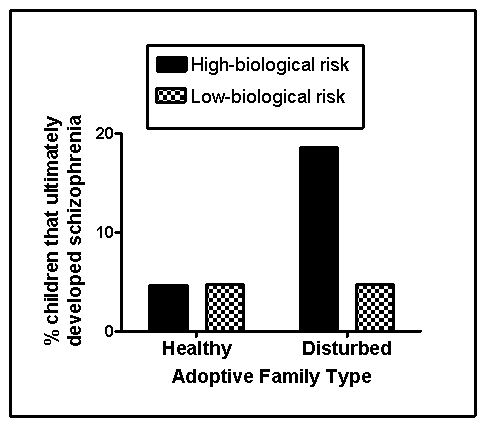Use the following to answer questions
Scenario II
The following scenario presents fabricated data consistent with the results of the following study:
Tienari,P. ,Wynne,L.C. ,Sorri,A. ,Lahti,I. ,Läksy,K. ,Moring,J. ,& ...Wahlberg,K.(2004) .Genotype-environment interaction in schizophrenia-spectrum disorder: Long-term follow-up study of Finnish adoptees.The British Journal of Psychiatry,184(3) ,216-222.doi:10.1192/bjp.184.3.216
Schizophrenia affects approximately 1% of the general population and is characterized by the profound disruption of basic psychological processes;a distorted perception of reality;altered or blunted emotional affect;and disturbances in thought,motivation,and behavior.The symptoms of schizophrenia are varied and are typically classified as either positive or negative.Positive symptoms of schizophrenia refer to thoughts and behaviors typically not observed in those without the disease and can include things like delusions (patently false beliefs) ,hallucinations (false perceptual experiences) ,and disorganized speech.Negative symptoms of schizophrenia are deficits or disruptions in normal behaviors,such as social withdrawal.Cognitive deficits in executive functioning,attention span,and working memory may also be observed.
The symptoms of schizophrenia usually begin in late adolescence and the disease has a strong genetic component.Over the years,a number of biological factors have been linked to schizophrenia,although none alone adequately accounts for the disorder.One such example is the dopamine hypothesis,which states that schizophrenia is related to an excess in dopamine activity.Another theory points to enlarged brain ventricles and progressive cortex tissue loss as predictive of schizophrenia.Although only a minority of persons with schizophrenia have enlarged ventricles,this structural anomaly can appear in those without the disease,and dopamine antagonists may also produce this effect.
Although research into the environmental determinants of schizophrenia has focused largely on the prenatal environment,psychological and social factors also contribute.Tienari and colleagues (2004) compared the risk of developing schizophrenia in children adopted into healthy versus disturbed families,the latter characterized by extreme conflict,volatile relationships,and communication deficits.Some of these children under investigation were identified as at-risk genetically for schizophrenia because their biological mothers were schizophrenic.The remainder were classified at low risk.The investigators utilized a longitudinal design and obtained the diagnostic status of the children with respect to schizophrenia when they reached young adulthood.Fabricated results consistent with this study are shown in Figure 15.2
Figure 15.2 
-(Scenario II) Numerous studies have demonstrated enlarged ventricles in patients with schizophrenia,particularly those exhibiting the negative symptoms of the disease.Why would interpretation of this finding NOT be complicated?
Definitions:
Social Linkage
The connections and relationships among people or groups that facilitate communication, interaction, or cooperation.
Reciprocal Obligations
Mutual duties or responsibilities that parties owe to each other.
Harmony
A state of agreement, concord, or peaceful relations among individuals or groups.
Roles
The functions or positions that individuals are expected to perform in a specific context or system.
Q4: Which symptom is a negative symptom of
Q19: Major depressive disorder is also known as
Q57: The Type _ behavior pattern is characterized
Q58: The biopsychosocial perspective assumes that mental disorders
Q65: Eddie often masturbates and defecates in public.Eddie
Q75: _,a physician,developed _ in the 1930s and
Q131: Tessa is severely depressed and has not
Q177: _ is the second leading cause of
Q216: Generalized anxiety disorder is LESS prevalent in:<br>A)women.<br>B)people
Q230: Which psychologist is conducting research in the